Effect of Countersample Coatings on the Friction Behaviour of DC01 Steel Sheets in Bending-under-Tension Friction Tests
Abstract
:1. Introduction
2. Test Material and Methods
2.1. Material
2.2. Experimental
3. Results and Discussion
3.1. Coefficient of Friction
3.2. Surface Topography
3.3. Temperature in the Contact Zone
4. Conclusions
- Under dry friction conditions, a clear increase in the CoF value, with the elongation of the samples for all analysed types of countersamples, was observed.
- Under conditions of dry friction, the highest value of the CoF, up to approximately 0.31, was recorded for the C-EBM countersample. Moreover, under lubricated conditions, the C-EBM countersample showed the highest CoF value, which is related to the much higher average roughness of this countersample compared to the other countersamples.
- Under lubricated conditions, the CoF was more stable compared to conditions of dry friction, and the uncoated countersample showed the most favourable friction conditions.
- For the uncoated countersample, oil with lower viscosity provided more favourable conditions for reducing the CoF. The most favourable conditions for reducing the CoF were provided by uncoated samples and lubrication with S100+ oil. In the case of the anti-wear coated countersamples, the variation of the CoF for both tested oils was similar.
- The average roughness decreased as a result of the friction tests, mainly as a result of the change in the topography of the sample surface caused by the elongation of the samples and the flattening mechanism of the surface asperities.
- After the friction process, kurtosis increased and skewness decreased compared to the as-received sheet metal. All surfaces after the friction process showed a negative skewness value, lower than the skewness of the as-received sheet surface. Dry friction involving an uncoated countersample led to the largest change in the value of kurtosis (Sku).
- During the friction test, a temperature change in the contact zone was observed between approximately 0.31 °C and 0.51 °C depending on the friction conditions. The lowest value of temperature increase in the contact zone, under all friction conditions, was observed for the C-EBM countersample, which is characterized as having the highest average surface roughness compared to other countersamples. High surface roughness limits the metallic contact of rubbing surfaces and, as a result, heat transfer.
Author Contributions
Funding
Institutional Review Board Statement
Informed Consent Statement
Data Availability Statement
Acknowledgments
Conflicts of Interest
References
- Trzepieciński, T. Approaches for preventing tool wear in sheet metal forming processes. Machines 2023, 11, 616. [Google Scholar] [CrossRef]
- Lachmayer, R.; Behrens, B.-A.; Ehlers, T.; Müller, P.; Althaus, P.; Oel, M.; Farahmand, E.; Gembarski, P.C.; Wester, H.; Hübner, S. Process-integrated lubrication in sheet metal forming. J. Manuf. Mater. Process. 2022, 6, 121. [Google Scholar] [CrossRef]
- Korfanty, K.; Żaba, K.; Szwachta, G.; Seibt, P.; Puchlerska, S. Selection of the tool materials, lubrications and self-lubricating coatings for the rotary forming process of nickel superalloys sheets. In Proceedings of the 25th Anniversary International Conference on Metallurgy and Materials, Brno, Czech Republic, 25–27 May 2016; TANGER Ltd.: Bushey, UK; pp. 421–426. [Google Scholar]
- Trzepieciński, T.; Szwajka, K.; Szewczyk, M. Analysis of coefficient of friction of deep-drawing-quality steel sheets using multi-layer neural networks. Lubricants 2024, 12, 50. [Google Scholar] [CrossRef]
- Najm, S.M.; Trzepieciński, T.; Ibrahim, O.M.; Szwajka, K.; Szewczyk, M. Analysis of the friction performance of deep-drawing steel sheets using network models. Int. J. Adv. Manuf. Technol. 2024, 132, 3757–3769. [Google Scholar] [CrossRef]
- Oprișan, C.M.; Chiriac, B.; Tufescu, A.; Olaru, D.N. Static and dynamic friction coefficient in low loads and sliding speed conditions. IOP Conf. Ser. Mater. Sci. Eng. 2022, 1262, 012012. [Google Scholar] [CrossRef]
- Martins, J.A.C.; Oden, J.T.; Simões, F.M.F. A study of static and kinetic friction. Int. J. Eng. Sci. 1990, 28, 29–92. [Google Scholar] [CrossRef]
- Xia, J.; Zhao, J.; Dou, S. Friction characteristics analysis of symmetric aluminum alloy parts in warm forming process. Symmetry 2022, 14, 166. [Google Scholar] [CrossRef]
- Gao, S.; Yang, L.H.; Gan, Y.; Chen, Q. The influence of sliding speed on the friction behavior of silica surface. ACS Omega 2021, 6, 3384–3389. [Google Scholar] [CrossRef] [PubMed]
- Białas, M.; Maciejewski, J.; Kucharski, S. Friction coefficient of solid lubricating coating as a function of contact pressure: Experimental results and microscale modeling. Cont. Mech. Thermodyn. 2021, 33, 1733–1745. [Google Scholar] [CrossRef]
- Kraus, M.; Lenzen, M.; Merklein, M. Contact pressure-dependent friction characterization by using a single sheet metal compression test. Wear 2021, 476, 203679. [Google Scholar] [CrossRef]
- Chandross, M.; Argibay, N. Friction of Metals: A review of microstructural evolution and nanoscale phenomena in shearing contacts. Tribol. Lett. 2021, 69, 119. [Google Scholar] [CrossRef]
- Najm, S.M.; Trzepieciński, T.; Kowalik, M. Modelling and parameter identification of coefficient of friction for deep-drawing quality steel sheets using the CatBoost machine learning algorithm and neural networks. Int. J. Adv. Manuf. Technol. 2023, 124, 2229–2259. [Google Scholar] [CrossRef]
- Bulikowska, B.; Gałda, L. The effect of surface roughness on the tribological properties of sliding elements in material assembly SiC–42CrMo4. Tribologia 2015, 262, 211–231. [Google Scholar]
- Podulka, P. Proposal of frequency-based decomposition approach for minimization of errors in surface texture parameter calculation. Surf. Interf. Anal. 2020, 52, 882–889. [Google Scholar] [CrossRef]
- Podulka, P. Selection of methods of surface texture characterisation for reduction of the frequency-based errors in the measurement and data analysis processes. Sensors 2022, 22, 791. [Google Scholar] [CrossRef] [PubMed]
- Mousawi, A.; Sperk, T.; Gietzelt, T.; Kunze, T.; Lasagni, A.F.; Brosius, A. Effect of contact area on friction force in sheet metal forming operations. Key Eng. Mater. 2018, 767, 77–84. [Google Scholar] [CrossRef]
- Moore, A.J.W.; Tegart, W.J.M. Relation between friction and hardness. Proc. Royal Soc. A 1952, 212, 453–458. [Google Scholar]
- Zhang, T.; Dong, L.; Wu, J.; Li, D. Modulation effect of hardness on the friction coefficient and its mechanism analysis of zrb2/mo multilayers synthesized by magnetron sputtering. Crystals 2021, 11, 69. [Google Scholar] [CrossRef]
- Djordjević, M.T.; Aleksandrović, S.; Arsić, D.; Nikolić, R.R.; Szmidla, J.; Todić, A.; Čukanović, D.; Ulewicz, R. Influence of TiN coating on the drawing force and friction coefficient in the deep drawing process of AlMg4.5Mn0.7 thin sheets. Materials 2023, 16, 3968. [Google Scholar] [CrossRef] [PubMed]
- Güler, E.S.; Büyüklüoğlu, B. The effects of coating conditions on the friction and corrosion resistance of carbon steel. Emerg. Mater. Res. 2020, 9, 383–387. [Google Scholar] [CrossRef]
- Gil, I.; Galdos, L.; Mugarra, E.; Mendiguren, J.; Saenz de Arandoña, E. Influence of the tool temperature increment on the coefficient of friction behavior on the deep drawing process of HSS. IOP Conf. Ser. Mater. Sci. Eng. 2016, 159, 012019. [Google Scholar] [CrossRef]
- Venema, J.; Hazrati, J.; Matthews, D.T.A.; Stegeman, R.A.; van den Boogaard, A.H. The effects of temperature on friction and wear mechanisms during direct press hardening of Al-Si coated ultra-high strength steel. Wear 2018, 406–407, 149–155. [Google Scholar] [CrossRef]
- Carvalho, L.A.; Lukacs, Z. The role of friction in the sheet metal forming numerical simulation. IOP Conf. Ser. Mater. Sci. Eng. 2022, 1246, 012021. [Google Scholar] [CrossRef]
- Narul, M.A.; Syahrullail, S. Lubricant viscosity: Evaluation between existing and alternative lubricant in metal forming process. Procedia Manuf. 2015, 2, 470–475. [Google Scholar] [CrossRef]
- Desplanques, Y. Amontons-Coulomb friction laws, A review of the original manuscript. SAE Int. J. Mater. Manuf. 2015, 8, 98–103. [Google Scholar] [CrossRef]
- Kumar, J.P.; Kumar, R.U.; Ramakrishna, B.; Ramu, B.; Saheb, K.B. Formability of sheet metals—A review. IOP Conf. Ser. Mater. Sci. Eng. 2018, 455, 012081. [Google Scholar] [CrossRef]
- Shisode, M.; Hazrati, J.; Mishra, T.; de Rooij, M.; van den Boogaard, T. Evolution of real area of contact due to combined normal load and sub-surface straining in sheet metal. Friction 2021, 9, 840–855. [Google Scholar] [CrossRef]
- Xu, D.; Yang, Q.; Wang, X.; He, H.; Sun, Y.; Li, W. An experimental investigation of steel surface topography transfer by cold rolling. Micromachines 2020, 11, 916. [Google Scholar] [CrossRef] [PubMed]
- Trzepieciński, T. The comparison of the multi-layer artificial neural network training methods in terms of the predictive quality of the coefficient of friction of 1.0338 (DC04) Steel Sheet. Materials 2024, 17, 908. [Google Scholar] [CrossRef] [PubMed]
- Seshacharyulu, K.; Bandhavi, C.; Naik, B.B.; Rao, S.S.; Singh, S.K. Understanding friction in sheet metal forming-A review. Mater. Today Proc. 2018, 5, 18238–18244. [Google Scholar] [CrossRef]
- Schell, L.; Groche, P. In search of the perfect sheet metal forming tribometer. In Forming the Future; Springer: Cham, Swizerland, 2021; pp. 81–96. [Google Scholar]
- Littlewood, M.; Wallace, J.F. The effect of surface finish and lubrication on the fictional variation involved in the sheet-metal-forming process. Sheet Metal Ind. 1964, 41, 925–930. [Google Scholar]
- Uko, D.K.; Sowerby, R.; Duncan, J.L. Strain distribution in the bending-under-tension test. CIM Bull. 1977, 70, 127–134. [Google Scholar]
- Kotchman, D.P.; Kim, I.; Sa, C.Y.; Lee, D. Determination of frictional behavior in sheet metals using orthogonal arrays. J. Mater. Eng. Perform. 1992, 1, 555–564. [Google Scholar] [CrossRef]
- Vallance, D.W.; Matlock, D.K. Application of the bending-under-tension friction test to coated sheet steels. J. Mater. Eng. Perform. 1992, 1, 685–693. [Google Scholar] [CrossRef]
- Andreasen, J.L.; Olsson, D.D.; Bay, N. Bending under tension test with direct friction measurement. Proc. Inst. Mech. Eng. Part B J. Eng. Manuf. 2006, 220, 73–80. [Google Scholar]
- Lemu, H.G.; Trzepieciński, T. Numerical and experimental study of frictional behavior in bending under tension test. Stroj. Vestn.-J. Mech. Eng. 2013, 59, 41–49. [Google Scholar] [CrossRef]
- Folle, L.F.; Schaeffer, L. Evaluation of contact pressure in bending under tension test by a pressure sensitive film. J. Surf. Eng. Mater. Adv. Technol. 2016, 6, 201–214. [Google Scholar] [CrossRef]
- Ceron, E.; Martins, P.A.F.; Bay, N. Thermal analysis of bending under tension test. Procedia Eng. 2014, 81, 1805–1810. [Google Scholar] [CrossRef]
- Wiklund, D.; Rosen, B.G.; Wihlborg, A. A friction model evaluated with results from a bending-under-tension test. Tribol. Int. 2009, 42, 1448–1452. [Google Scholar] [CrossRef]
- Trzepiecinski, T.; Lemu, H.G. Effect of lubrication on friction in bending under tension test-experimental and numerical approach. Metals 2020, 10, 544. [Google Scholar] [CrossRef]
- Sniekers, R.J.J.M.; Smits, H.A.A. Experimental set-up and data processing of the radial strip-drawing friction test. J. Mater. Process. Technol. 1997, 66, 216–223. [Google Scholar] [CrossRef]
- Kim, Y.S.; Jain, M.K.; Metzger, D.R. Non-uniform pressure distribution in draw-bend friction test and its influence on friction measurement. AIP Conf. Proc. 2005, 778, 661–666. [Google Scholar]
- Nielsen, C.V.; Legarth, B.H.; Niordson, C.F.; Bay, N. A correction to the analysis of bending under tension tests. Tribol. Int. 2022, 173, 107625. [Google Scholar] [CrossRef]
- EN 10130:2009; Cold Rolled Low Carbon Steel Flat Products for Cold Forming. Technical Delivery Conditions. European Committee for Standardization: Brussels, Belgium, 2009.
- EN ISO 6892-1:2020; Metallic Materials—Tensile Testing—Part 1: Method of Test at Room Temperature. International Organization for Standardization: Geneva, Switzerland, 2020.
- ISO 25178-2:2012; Geometrical Product Specifications (GPS)—Surface Texture: Areal—Part 2: Terms, Definitions and Surface Texture Parameters. International Organization for Standardization: Geneva, Switzerland, 2012.
- Duncan, J.L.; Shabel, B.S.; Filho, J.G. A tensile strip test for evaluating friction in sheet metal forming. SAE Tech. Pap. 1978, 780391, 1–12. [Google Scholar]
- ISO 6507-1:2023; Metallic Materials. Vickers Hardness Test. Part 1: Test Method. International Organization for Standardization: Geneva, Switzerland, 2023.
- ISO 4287:1997; Geometrical Product Specifications (GPS)-Surface Texture: Profile Method-Terms, Definitions and Surface Texture Parameters (JIS B 0601: 2013). ISO: Geneva, Switzerland, 1997.
- Payen, G.R.; Felder, E.; Repoux, M.; Mataigne, J.M. Influence of contact pressure and boundary films on the frictional behaviour and on the roughness changes of galvanized steel sheets. Wear 2012, 276–277, 48–52. [Google Scholar] [CrossRef]
- Wilhborg, A.; Gunnarsson, L. A frictional study of uncoated EBT steel sheets in a bending under tension friction test. Wear 2000, 237, 129–136. [Google Scholar] [CrossRef]
- Shisode, M.; Hazrati, J.; Mishra, T.; de Rooij, M.; ten Horn, C.; van Beeck, J.; van den Boogaard, T. Modeling boundary friction of coated sheets in sheet metal forming. Tribol. Int. 2021, 153, 106554. [Google Scholar] [CrossRef]
- Zwicker, M.; Bay, N.; Nielsen, C.V. A discussion of model asperities as a method to study friction in metal forming. Discov. Mech. Eng. 2023, 2, 3. [Google Scholar] [CrossRef]
- Slota, J.; Kaščák, Ľ.; Lăzărescu, L. Frictional characteristics of EN AW-6082 aluminium alloy sheets used in metal forming. Adv. Mech. Mater. Eng. 2024, 41, 79–87. [Google Scholar] [CrossRef]
- Szewczyk, M.; Szwajka, K.; Najm, S.M.; Mohammed, S.O. Application of categorical boosting to modelling the friction behaviour of DC05 steel sheets in strip drawing test. Adv. Mech. Mater. Eng. 2024, 41, 69–78. [Google Scholar] [CrossRef]
- Wiercigroch, M. A note on the switch function for the stick-slip phenomenon. J. Sound Vib. 1994, 175, 700–704. [Google Scholar] [CrossRef]
- Huang, J.H. Coefficients of friction: Static versus dynamic. In Proceedings of the 2020 Join Rail Conference, St. Louis, MO, USA, 20–22 April 2020; pp. 1–4. [Google Scholar]
- Sedlaček, M.; Podgornik, B.; Vižintin, J. Influence of surface preparation on roughness parameters, friction and wear. Wear 2009, 266, 482–487. [Google Scholar] [CrossRef]
- Sedlaček, M.; Vilhena, L.M.S.; Podgornik, B.; Vižintin, J. Surface topography modelling for reduced friction. Stroj. Vestn.-J. Mech. Eng. 2011, 57, 674–680. [Google Scholar] [CrossRef]
- Gadelmawla, E.S.; Koura, M.M.; Maksoud, T.M.A.; Elewa, I.M.; Soliman, H.H. Roughness parameters. J. Mater. Proc. Technol. 2002, 123, 133–145. [Google Scholar] [CrossRef]
- Wang, W.Z.; Chen, H.; Hu, Y.Z.; Wang, H. Effect of surface roughness parameters on mixed lubrication characteristics. Tribol. Int. 2006, 39, 522–527. [Google Scholar] [CrossRef]
- Tayebi, N.; Polycarpou, A.A. Modeling the effect of skewness and kurtosis on the static coefficient of rough surfaces. Tribol. Int. 2004, 37, 491–505. [Google Scholar] [CrossRef]
- Sedlaček, M.; Podgornik, B.; Vižintin, J. Correlation between standard roughness parameters skewness and kurtosis and tribological behaviour of contact surfaces. Tribol. Int. 2012, 48, 102–112. [Google Scholar] [CrossRef]
- Filzek, J.; Keil, D.; Schröder, H. Temperature induced friction increase in friction test and forming demonstrator for sheet metal forming. In Proceedings of the 24th International Conference on Material Forming (ESAFORM 2021), Liège, Belgium, 14–16 April 2021. [Google Scholar]
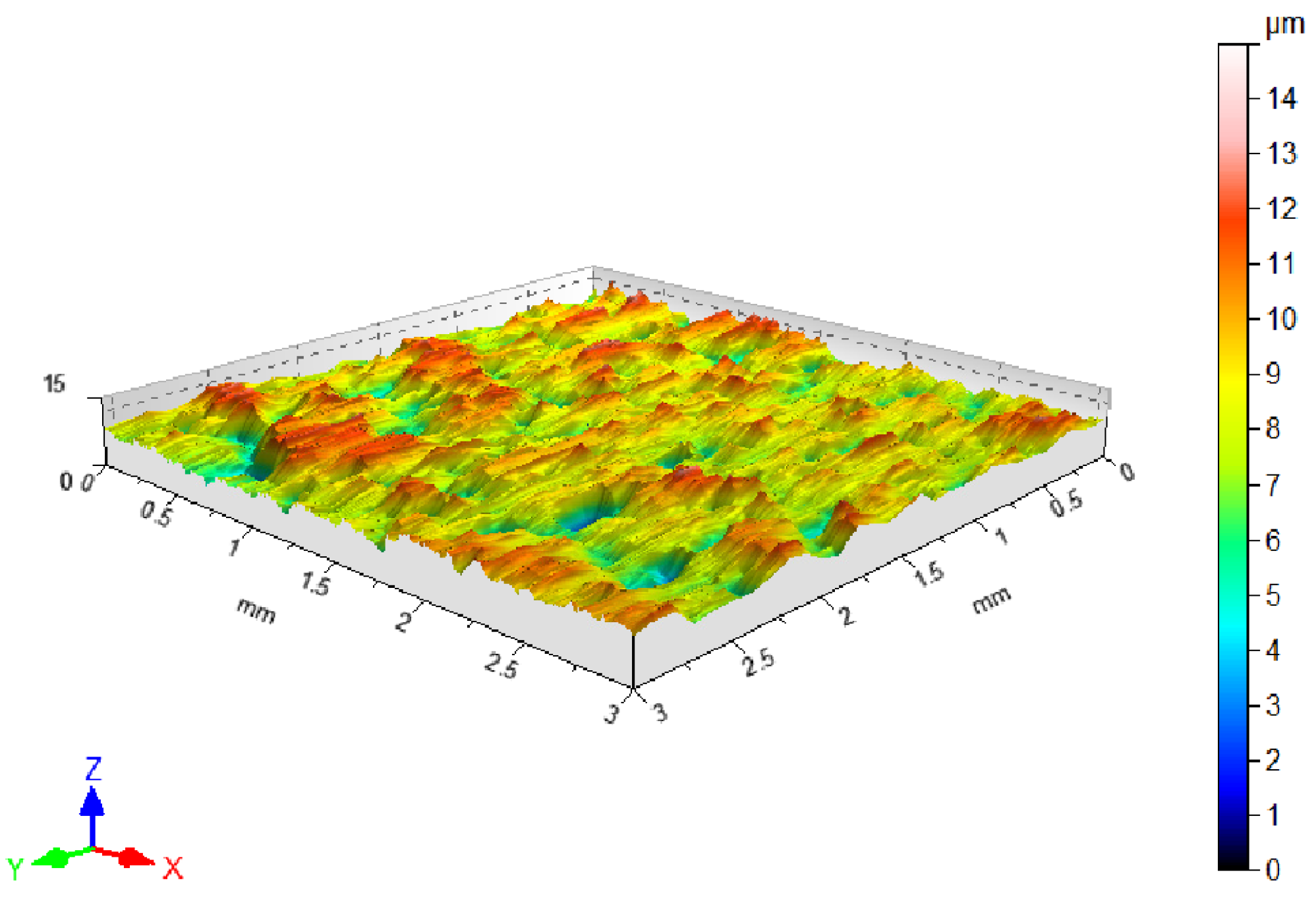
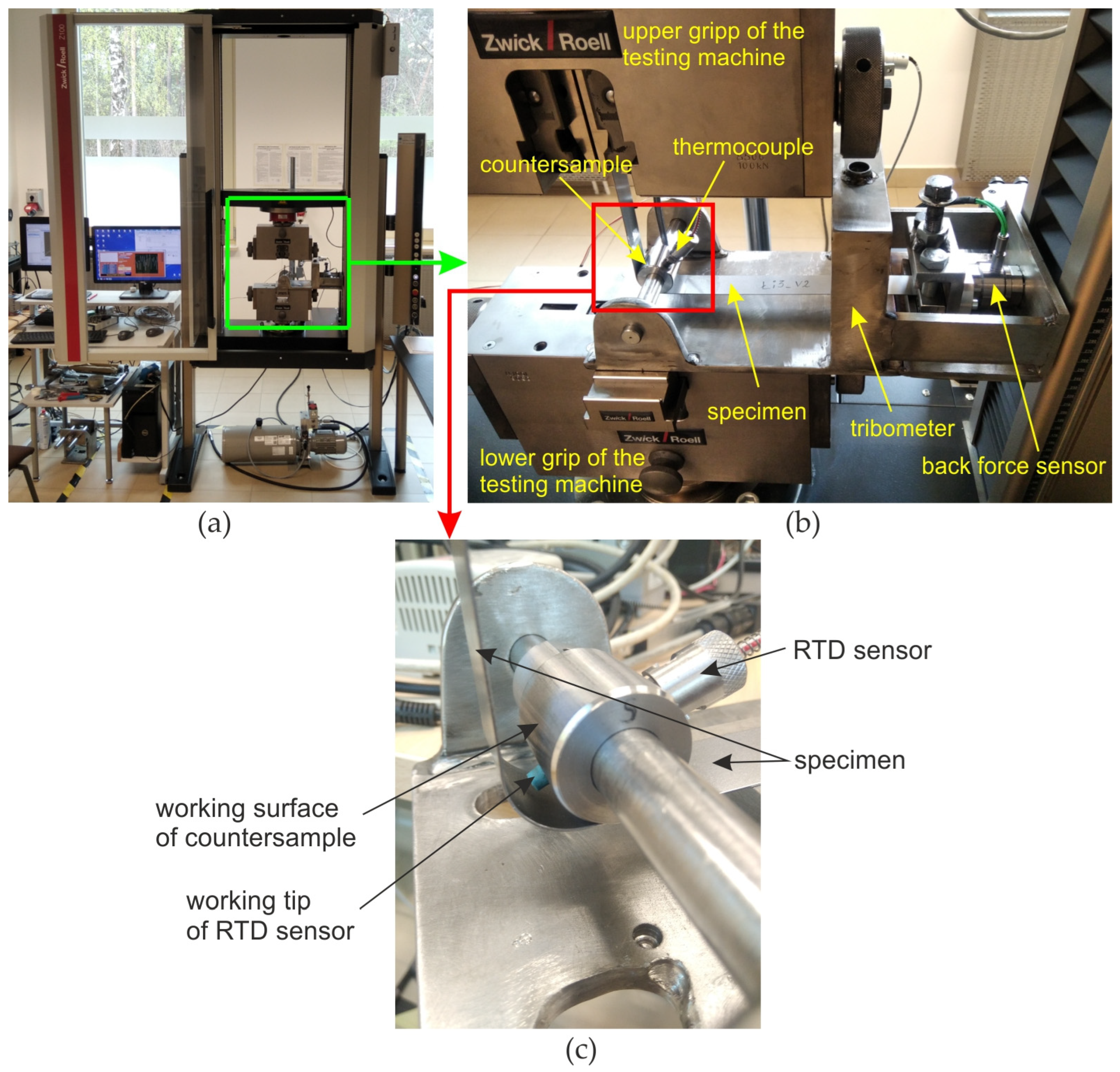
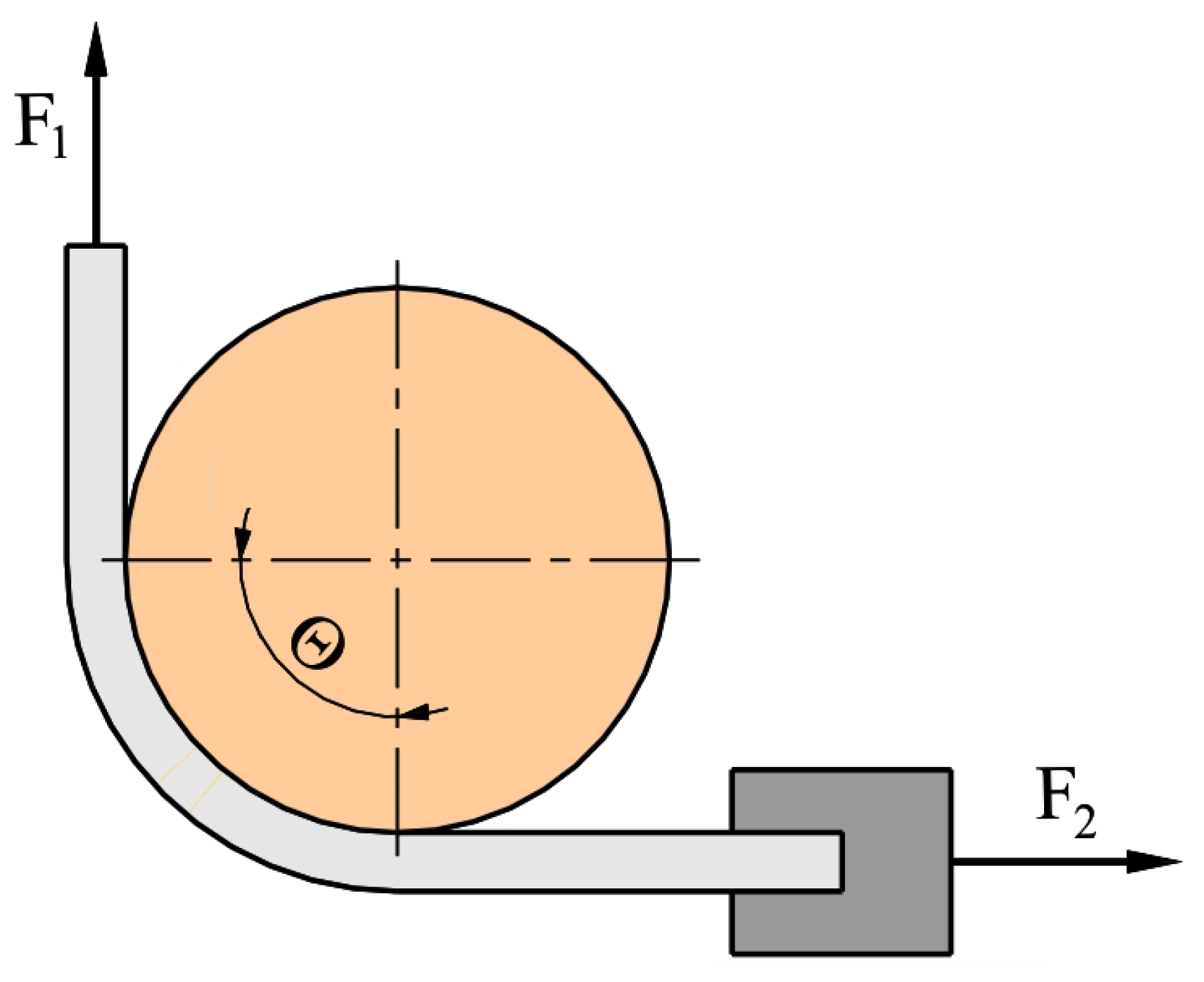
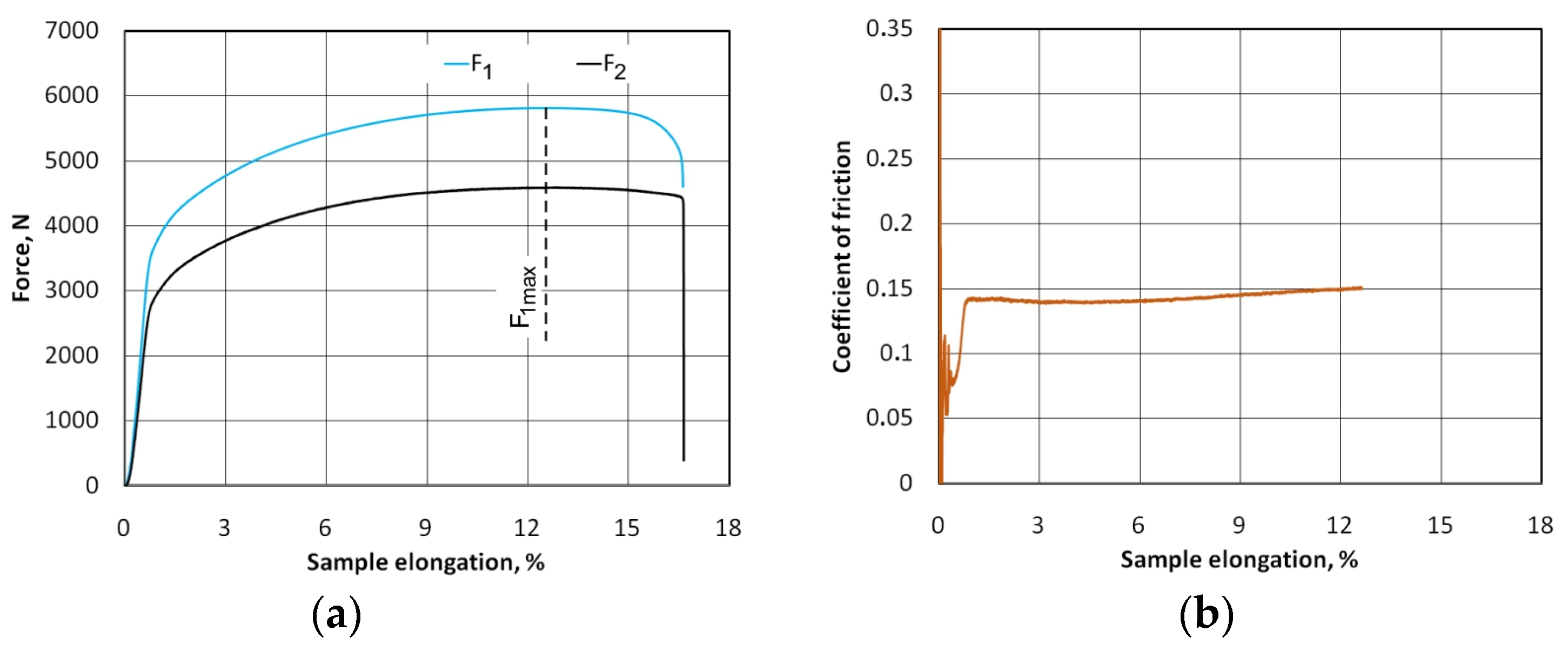
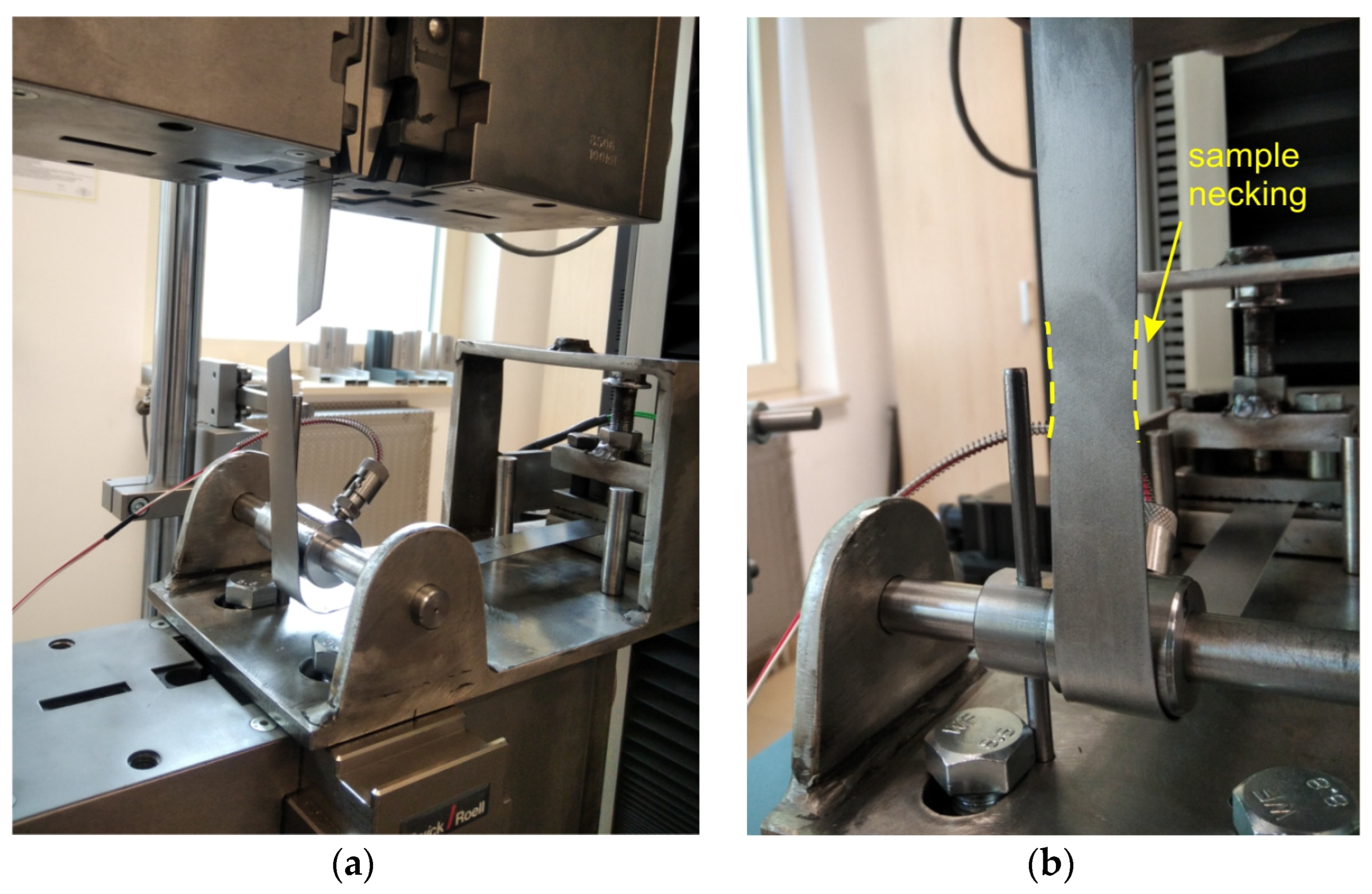

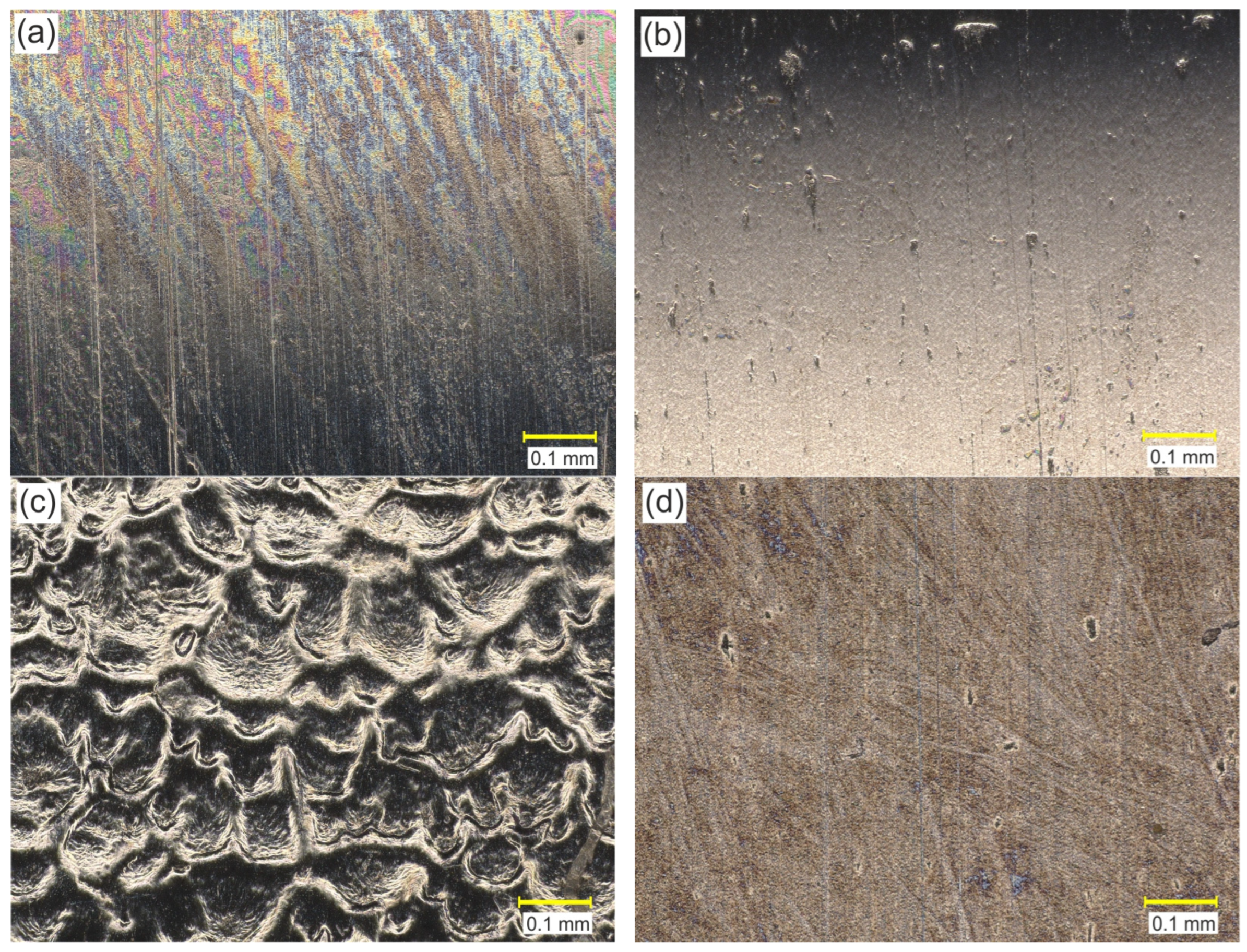
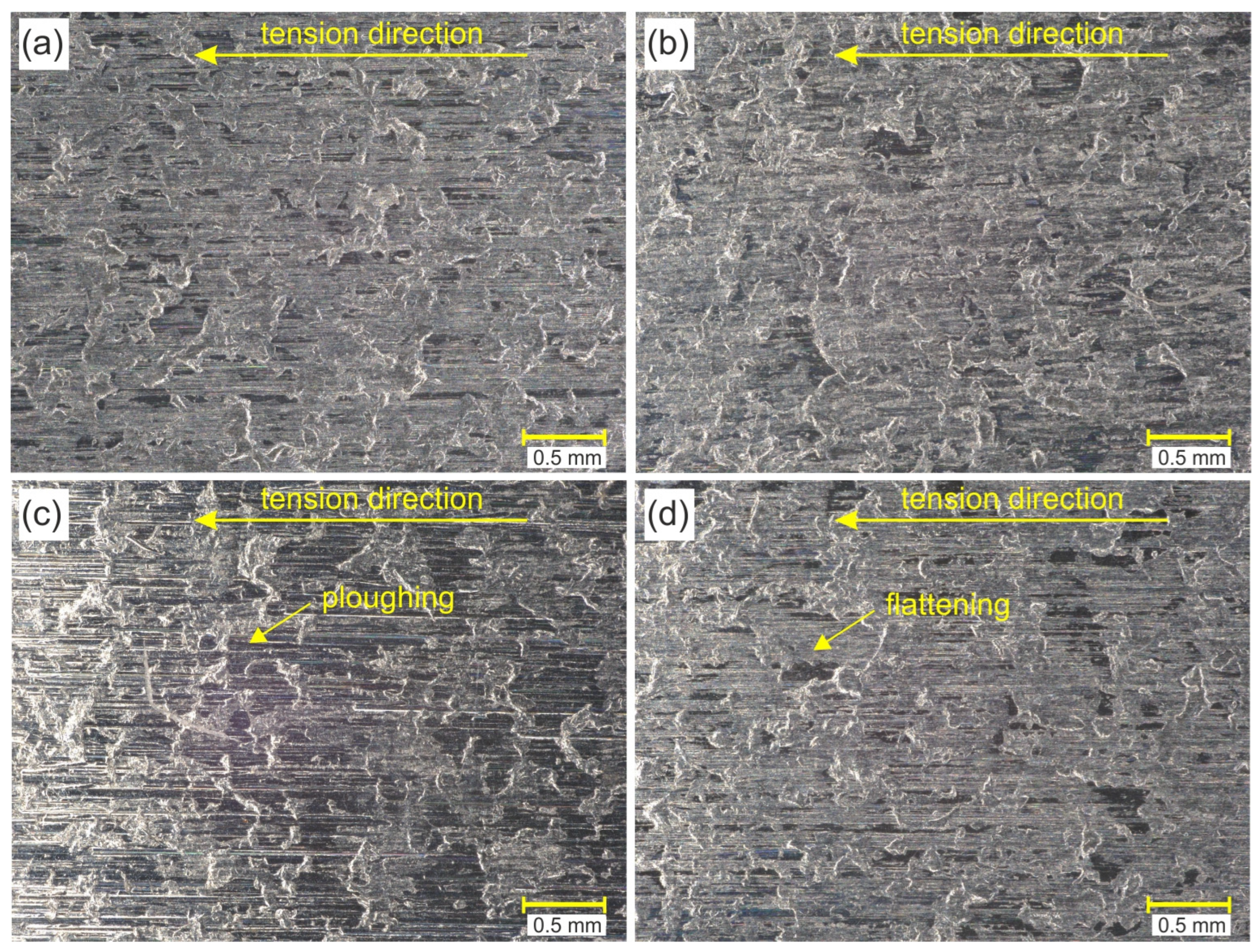
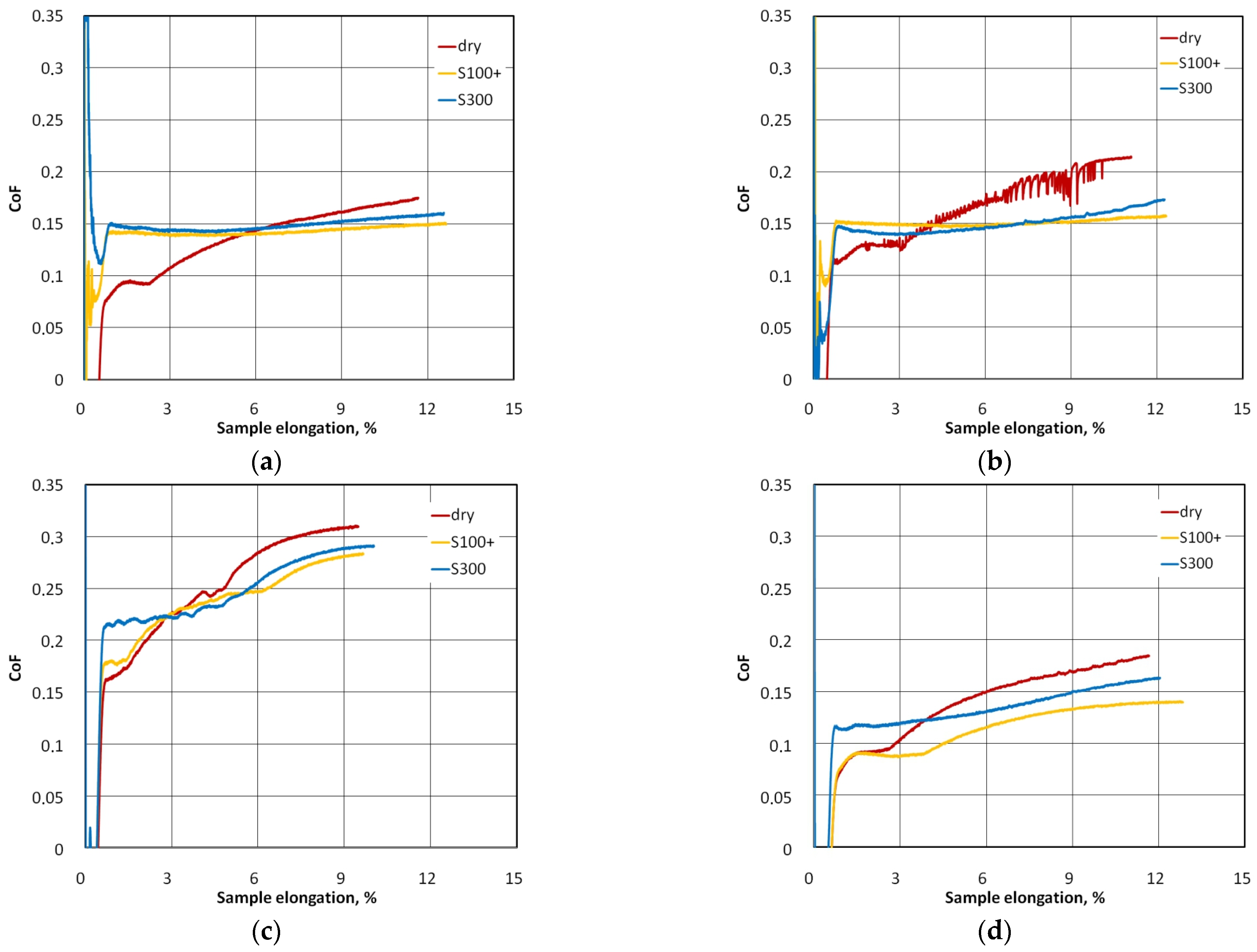


| C | Mn | S | P | Fe |
|---|---|---|---|---|
| ≤0.06 | ≤0.35 | ≤0.025 | ≤0.025 | remainder |
| Sample Orientation | Yield Stress, MPa | Ultimate Tensile Strength, MPa | Elongation, % |
|---|---|---|---|
| 0° | 163.4 ± 2.16 | 290.15 ± 1.53 | 37.63 ± 0.11 |
| 90° | 157.7 ± 3.36 | 278.9 ± 0.57 | 35.84 ± 0.36 |
| Sa, μm | Sq, μm | Sz, μm | Sv, μm | Sp, μm | Sku | Ssk |
|---|---|---|---|---|---|---|
| 1.28 | 1.63 | 13.5 | 8.39 | 5.09 | 3.63 | −0.407 |
| Denotation of Countersample | Method of Preparation of Countersample Surface | Hardness, HV |
|---|---|---|
| C-Ti-N | Titanium- and nitrogen-ion implantation (dose: 5 × 1017 cm−2, accelerating voltage: 60 kV) + nitrogen-ion implantation (dose: 5 × 1017 cm−2, accelerating voltage: 60 kV) | 305 |
| C-N | Nitrogen-ion implantation (dose: 5 × 1017 cm−2, accelerating voltage: 60 kV) | 306.8 |
| C-EBM | Electron beam melting (energy density of the electron pulse: 3.13 J/cm2) | 174.6 |
| C-U | Uncoated | 309.4 |
| Denotation of Countersample | Ra, μm | Rq, μm | Rz, μm | Rv, μm | Rp, μm | Rku | Rsk |
|---|---|---|---|---|---|---|---|
| C-Ti-N | 0.03848 | 0.0539 | 0.4354 | 0.2816 | 0.1538 | 7.936 | −0.7892 |
| C-N | 0.0705 | 0.1292 | 1.1392 | 0.961 | 0.1808 | 22.6 | −3.384 |
| C-EBM | 1.382 | 1.682 | 7.264 | 3.082 | 4.182 | 2.638 | 0.3958 |
| C-U | 0.0363 | 0.0543 | 0.508 | 0.3474 | 0.1608 | 13.72 | −1.402 |
| Coating Type | Friction Conditions | Sp μm | Sv μm | Sz μm | Sa μm | Sq μm | Ssk | Sku |
|---|---|---|---|---|---|---|---|---|
| As received | 5.09 | 8.39 | 13.5 | 1.280 | 1.63 | −0.41 | 3.63 | |
| C-Ti-N | DF | 2.34 | 7.48 | 9.82 | 0.915 | 1.17 | −1.10 | 4.64 |
| S100+ | 2.41 | 8.04 | 10.5 | 0.827 | 1.09 | −1.35 | 5.95 | |
| S300 | 2.00 | 11.00 | 13.0 | 0.788 | 1.05 | −1.60 | 7.16 | |
| C-N | DF | 2.68 | 9.91 | 12.6 | 0.922 | 1.23 | −1.55 | 7.3 |
| S100+ | 2.16 | 11.8 | 14. | 1.020 | 1.34 | −1.55 | 7.41 | |
| S300 | 2.21 | 11.2 | 13.4 | 0.944 | 1.27 | −1.65 | 7.44 | |
| C-EBM | DF | 5.46 | 8.53 | 14.0 | 0.894 | 1.18 | −1.09 | 5.6 |
| S100+ | 3.84 | 9.01 | 12.8 | 0.953 | 1.27 | −1.26 | 6.14 | |
| S300 | 3.94 | 8.62 | 12.6 | 0.889 | 1.18 | −1.22 | 5.94 | |
| C-U | DF | 3.03 | 11.50 | 14.5 | 1.020 | 1.38 | −1.38 | 8.81 |
| S100+ | 2.04 | 9.51 | 11.5 | 0.840 | 1.09 | −1.35 | 5.87 | |
| S300 | 2.19 | 7.61 | 9.8 | 0.968 | 1.25 | −1.23 | 4.95 | |
Disclaimer/Publisher’s Note: The statements, opinions and data contained in all publications are solely those of the individual author(s) and contributor(s) and not of MDPI and/or the editor(s). MDPI and/or the editor(s) disclaim responsibility for any injury to people or property resulting from any ideas, methods, instructions or products referred to in the content. |
© 2024 by the authors. Licensee MDPI, Basel, Switzerland. This article is an open access article distributed under the terms and conditions of the Creative Commons Attribution (CC BY) license (https://creativecommons.org/licenses/by/4.0/).
Share and Cite
Trzepieciński, T.; Szwajka, K.; Szewczyk, M.; Barlak, M.; Zielińska-Szwajka, J. Effect of Countersample Coatings on the Friction Behaviour of DC01 Steel Sheets in Bending-under-Tension Friction Tests. Materials 2024, 17, 3631. https://doi.org/10.3390/ma17153631
Trzepieciński T, Szwajka K, Szewczyk M, Barlak M, Zielińska-Szwajka J. Effect of Countersample Coatings on the Friction Behaviour of DC01 Steel Sheets in Bending-under-Tension Friction Tests. Materials. 2024; 17(15):3631. https://doi.org/10.3390/ma17153631
Chicago/Turabian StyleTrzepieciński, Tomasz, Krzysztof Szwajka, Marek Szewczyk, Marek Barlak, and Joanna Zielińska-Szwajka. 2024. "Effect of Countersample Coatings on the Friction Behaviour of DC01 Steel Sheets in Bending-under-Tension Friction Tests" Materials 17, no. 15: 3631. https://doi.org/10.3390/ma17153631






